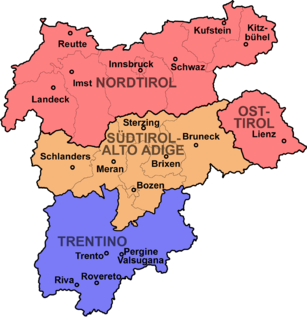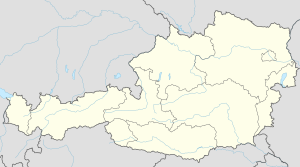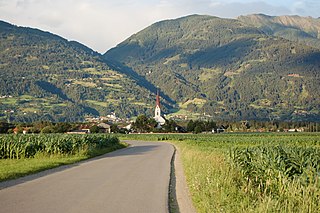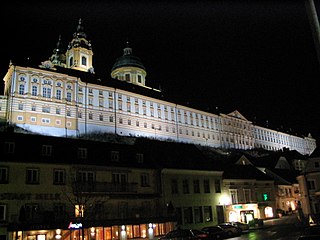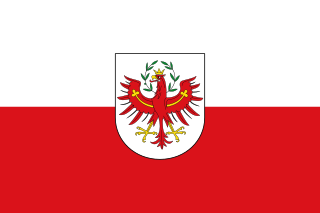
Tyrol is a federal state (Bundesland) in western Austria. It comprises the Austrian part of the historical Princely County of Tyrol. It is a constituent part of the present-day Euroregion Tyrol–South Tyrol–Trentino. The capital of Tyrol is Innsbruck.

Kilcrea Friary is a medieval abbey located near Ovens in County Cork, Ireland, west of Cork city. Both the friary and Kilcrea Castle, which stands in ruin to the west, were built by the Franciscans in the mid 15th century. The friary was established in 1465 by the Franciscan order under the patronage of Cormac Láidir MacCarthy, the Lord of Muskerry, who was killed in battle in 1494 and is buried at the site.

Lurnfeld is a market town in the district of Spittal an der Drau in the Austrian state of Carinthia. The municipality consists of the two Katastralgemeinden: Möllbrücke and Pusarnitz, comprising several small villages.

Obertilliach is a municipality in the district of Lienz, in the Austrian state of Tyrol.

Maria Schmolln is a municipality in the district of Braunau am Inn of the Austrian state of Upper Austria state. The community is mainly known as an important pilgrimage destination among rural Innviertel. The name comes from its location on the “Schmollner Berg”, literally small mountain.
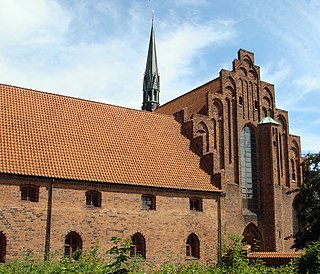
The Carmelite Priory, Helsingør, or Priory of Our Lady, Helsingør was a house of Carmelite friars in Helsingør, Zealand, Denmark, established in 1430. It is the finest example of a complete monastic complex surviving in Denmark, and one of the best in all of Scandinavia.

Archduchess Maria Theresa of Austria-Este was a member of the House of Austria-Este and Archduchess of Austria, Princess of Hungary, Bohemia, and Modena by birth. Henri was disputedly King of France and Navarre from 2 to 9 August 1830 and afterwards the Legitimist pretender to the throne of France from 1844 to 1883. Maria Theresa was the eldest child of Francis IV, Duke of Modena and his niece-wife Maria Beatrice of Savoy.

The Tyrolean Rebellion of 1809 was a rebellion of peasants in the County of Tyrol led by Andreas Hofer against the occupation of their homeland by the French and Bavarian troops within the context of the War of the Fifth Coalition against Napoleon I.

The Franciscan Friary of Rothenburg ob der Tauber is a former friary of the Conventual Franciscans in the town of Rothenburg ob der Tauber in Bavaria in the diocese of Bamberg. Nowadays the former Franciscan church is an Evangelical Lutheran parish church.

The Tyrolean Folk Art Museum is considered one of the finest regional heritage museums in Europe. Located next to the Hofkirche and across from the Hofburg in the Altstadt section of Innsbruck, Austria, the museum contains the most important collection of cultural artifacts from the Tyrol region.

The Franciscan Friary, Bolzano is a Franciscan friary in the city of Bolzano, in South Tyrol, northern Italy. It was founded in 1221, less than a century after Bolzano was refounded as a trading centre on the important Brenner route connecting the March of Verona and Italy with the Holy Roman Empire north of The Alps.

Reutte Friary is a former Roman Catholic Franciscan religious community and its associated church in the market town of Reutte in the Austrian Tirol, some 100 km to the west of Innsbruck. The church and the conventual complex of which it is a part enjoy Protected Monument status under Austrian law. The last Franciscans left the friary at the end of 2014, however, as part of a more general retrenchment, following several decades of decline in the numbers coming forward as novices.

Kaltern Friary is a Franciscan friary in Kaltern, South Tyrol, Italy. It is located in the centre of the little town and dates back to the 17th century.

Villach Friary is a Franciscan friary, responsible for the parish of St. Nicholas in Villach, Carinthia, Austria.
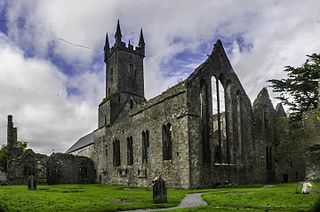
Ennis Friary was a Franciscan friary in the town of Ennis, County Clare, Ireland. It was established in the middle of the 13th century by the ruling O'Brien dynasty who supported it for most of its existence. Following the suppression of the monasteries in the 16th century, the friary continued to function for a while despite the loss of its lands. In the early 17th century, the buildings were handed over to the Church of Ireland as a place of worship. It was used as such until the late 19th century. After the construction of a new Church of Ireland building, the friary fell into ruin. Managed by the Office of Public Works since the late 19th century, it was formally returned to the Franciscan Order in 1969.


